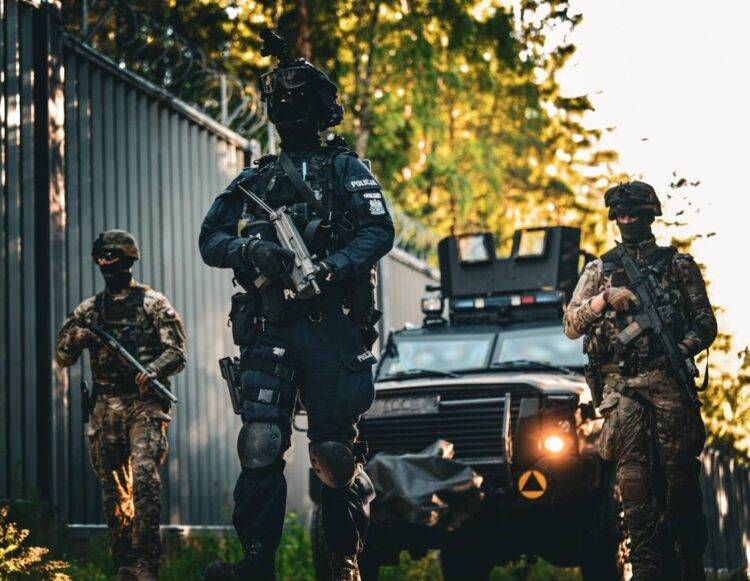Polish authorities reported a sharp escalation in tensions along the country’s eastern border with Belarus, accusing the regime of Alexander Lukashenko of intensifying hybrid operations involving violent migrant incursions. Defense officials say foreign nationals—allegedly directed by Belarusian and Russian services—are increasingly using aggressive tactics in attempts to penetrate Poland’s fortified frontier.
Defense Minister and Deputy Prime Minister Władysław Kosiniak-Kamysz said Saturday that nearly 300 attempts to illegally cross into Poland from Belarus were thwarted in a single night between Friday and Saturday. Migrants, acting in large coordinated groups, reportedly hurled stones and branches at Polish border guards, and some used angle grinders in an attempt to breach the steel barrier.
“The brutality is rising,” Kosiniak-Kamysz told reporters after receiving a field report from General Maciej Klisz, Operational Commander of the Armed Forces. “This is not a natural migration route. This entire operation is manufactured and orchestrated.”
“They won’t find a way into Europe”
The minister emphasized that the current border crisis is not about individuals seeking asylum but rather about an engineered effort to destabilize Poland and the European Union. “It’s an attack on Poland, not a search for shelter,” he said, warning migrants not to fall into what he called a “trap set by the Belarusian and Russian regimes.”
In response to the mounting pressure, Poland has intensified its security posture. Kosiniak-Kamysz touted the military’s 98% success rate in border protection, attributing it to a restructured defense strategy and more advanced surveillance technology.
He also highlighted that Poland no longer processes asylum claims from those who cross the border illegally, and that this new legal stance will be actively communicated in countries of migrant origin through an international media campaign.
“Those who think they’ll find an illegal path into Europe through Belarus will not succeed,” he added. “We want to warn them for their own safety.”
Government doubles down on deterrence
Poland’s Ministry of the Interior (MSWiA) recently implemented a regulation that temporarily limits the right to request international protection at the eastern border. The policy came into force on March 27 and is set to remain effective for 60 days, with the possibility of extension pending parliamentary approval.
Interior Minister Tomasz Siemoniak and ministry spokesperson Jacek Dobrzyński also confirmed the rising intensity of illegal crossings. “Every approach to the barrier is detected immediately, especially attempts to breach it,” Dobrzyński stated via social media, referring to Poland’s electronic monitoring systems.
Currently, around 11,000 personnel from the Polish Army and various security services are stationed along the border. They are supported by a dual-layer barrier system: a 5.5-meter-tall steel fence erected in 2022 and a digital “electronic barrier” equipped with sensors and surveillance equipment.
The government has also reintroduced and expanded a buffer zone in Podlaskie Voivodeship, stretching over 78 kilometers near nature reserves and sensitive border regions. Access is now restricted in zones ranging from 200 meters to four kilometers in width, depending on location.
A longer crisis with deep geopolitical roots
The current crisis is part of a broader hybrid campaign initiated by Minsk in 2021, widely viewed by NATO and EU nations as a retaliatory tactic against Western sanctions. Under Lukashenko’s direction, Belarus has been accused of facilitating the transport of migrants—mainly from the Middle East and Africa—to its western borders in an attempt to destabilize neighboring countries.
While the initial wave of border confrontations peaked in late 2021, Polish officials now claim the operations are undergoing a resurgence, with Russia’s alleged involvement adding a new layer of complexity. Kosiniak-Kamysz framed the strategy as an effort to strain European cohesion during a period already marked by the war in Ukraine and other regional tensions.
“This is not about helping people in need,” the defense chief insisted. “It’s about using human beings as instruments in a hostile political scheme.”
The previous Law and Justice (PiS) government had also launched public awareness campaigns targeting migrant-sending countries, though Kosiniak-Kamysz dismissed those efforts as ineffective. The current administration, under Prime Minister Donald Tusk, plans to launch a revamped campaign aimed at seven key countries. Officials say it will focus on deterring potential migrants from embarking on journeys that, according to Polish intelligence, are facilitated and manipulated by Belarusian operatives.
Border remains closed—and on alert
As Warsaw continues to adapt its border strategy, both physical and legislative tools are being reconfigured to counter the perceived threat. The state-of-the-art barrier—now reinforced with additional steel crossbars and razor wire—serves as the centerpiece of these efforts. Combined with real-time surveillance systems, the Polish-Belarusian frontier is among the most militarized in Europe.
Still, Polish officials remain wary of further escalation. “We have to stay vigilant,” said Siemoniak, noting that border security is now a regional concern involving cooperation with other EU nations.
With summer approaching, authorities anticipate a potential increase in border pressures. For now, the message from Warsaw is unambiguous: illegal crossings will not be tolerated, and Poland will continue to resist what it views as a hostile foreign operation.


















